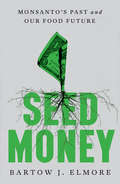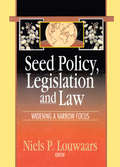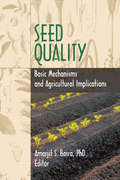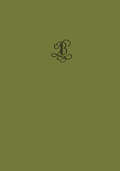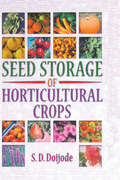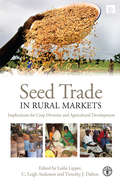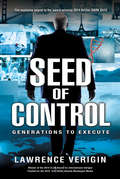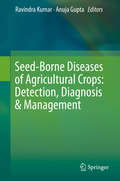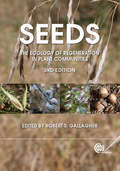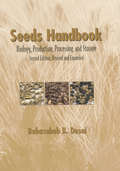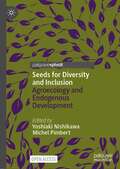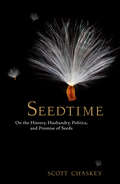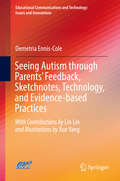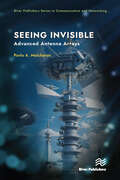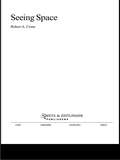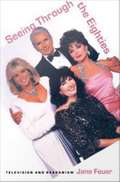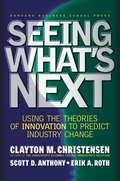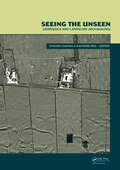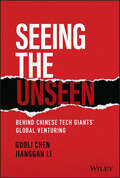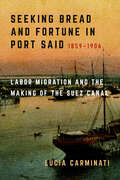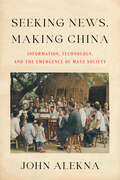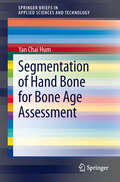- Table View
- List View
Seed Money: Monsanto's Past And Our Food Future
by Bartow J. ElmoreAn authoritative and eye-opening history that examines how Monsanto came to have outsized influence over our food system. Monsanto, a St. Louis chemical firm that became the world’s largest maker of genetically engineered seeds, merged with German pharma-biotech giant Bayer in 2018—but its Roundup Ready® seeds, introduced twenty-five years ago, are still reshaping the farms that feed us. When researchers found trace amounts of the firm’s blockbuster herbicide in breakfast cereal bowls, Monsanto faced public outcry. Award-winning historian Bartow J. Elmore shows how the Roundup story is just one of the troubling threads of Monsanto’s past, many told here and woven together for the first time. A company employee sitting on potentially explosive information who weighs risking everything to tell his story. A town whose residents are urged to avoid their basements because Monsanto’s radioactive waste laces their homes’ foundations. Factory workers who peel off layers of their skin before accepting cash bonuses to continue dirty jobs. An executive wrestling with the ethics of selling a profitable product he knew was toxic. Incorporating global fieldwork, interviews with company employees, and untapped corporate and government records, Elmore traces Monsanto’s astounding evolution from a scrappy chemical startup to a global agribusiness powerhouse. Monsanto used seed money derived from toxic products—including PCBs and Agent Orange—to build an agricultural empire, promising endless bounty through its genetically engineered technology. Skyrocketing sales of Monsanto’s new Roundup Ready system stunned even those in the seed trade, who marveled at the influx of cash and lavish incentives into their sleepy sector. But as new data emerges about the Roundup system, and as Bayer faces a tide of lawsuits over Monsanto products past and present, Elmore’s urgent history shows how our food future is still very much tethered to the company’s chemical past.
Seed Policy, Legislation and Law: Widening a Narrow Focus
by Neils P LouwaarsLearn what it takes to create and implement a truly successful seed policy!This unique book brings together international experts on seed policy and law. While other books approach the subject from the perspective of seed industry development and privatization, Seed Policy, Legislation, and Law makes clear that a successful national seed
Seed Quality: Basic Mechanisms and Agricultural Implications
by Robert E GoughSeed Quality: Basic Mechanisms and Agricultural Implications focuses on various aspects of seed quality and integrates research at basic and applied levels, supporting high-quality seeds as the basis of higher agricultural productivity. With its clear perspective and interdisciplinary focus on basic and applied aspects of seed quality, this book is immensely useful to students and teachers in many agricultural and botanical disciplines.Because seed quality is a critical component in the economic considerations of the farmer and the seedman alike, Basra looks in-depth at these aspects of seed production:seed viabilityseed healthseed vigorseed testingvariety identificationcrop yieldseed storageseed productionseed deteriorationseed treatmentsSeed quality is of international agronomic concern, and the recent upsurge of interest in seed quality has accentuated a new awareness regarding its importance in crop production. This book meets the need for information and could form the basis of long-range planning by policymakers on quality assurance and management programs and in the facilitation of international trade. Researchers, students, and teachers in many agricultural and botanical disciplines--seed science and technology in particular--will find this book to be of immense use. It can be used as a handbook for those involved in seed industry and seed testing services. It is recommended for international courses in seed science and technology and seed training programs.
Seed Regeneration in Cross-pollinated Species
by E. PorcedduThis book deals with the practical aspects in regeneration of field crop plants; regeneration of pasture plants; and regeneration of horticultural plants. It discusses the methods to increase seed stocks of cross-pollinated species.
Seed Storage of Horticultural Crops
by S.d. DoijodeMaintain viability with these techniques for proper seed storage!Healthy, viable seeds are the foundation for sustainable crop production, while poorly kept seeds can result in low germination and crop loss. Seed Storage of Horticultural Crops suggests appropriate strategies to help farmers and breeders store seeds of all kinds.
Seed Trade in Rural Markets: Implications for Crop Diversity and Agricultural Development
by Leslie Lipper Leigh Anderson Timothy J. DaltonMarkets have been found to be an increasingly important source of the seeds of crops and varieties low income farmers need to improve their livelihoods, encompassing both the formal and informal seed sector. Markets also have major impacts on agricultural biodiversity, by affecting farmers' choice of crops and varieties to grow. They are not, however, a homogenous institution, although all too frequently policies and regulations are developed as though they were. Markets vary considerably depending on the participants, on the institutions that govern how and what they exchange, and on local agricultural, economic and social conditions. Developing effective strategies to improve the way agricultural markets work, including how farmers use crop genetic resources, requires understanding of these variations. Seed Trade in Rural Markets presents a unique set of case studies from Bolivia, India, Kenya, Mali and Mexico on agricultural seed and product markets that describe three important market characteristics expected to affect farmers' access to seeds and varieties: the range of varieties on offer, the information provided about them, and relative prices. The case studies - all based around a common framework to aid comparability - also provide information on social, agricultural and economic factors which may be affecting the market availability, information, and cost of crop genetic resources, and ultimately the capacity to stimulate agricultural development Published with the Food and Agriculture Organization (FAO) of the United Nations
Seed of Control: Generations to Execute
by Lawrence VeriginSeed of Control is the explosive sequel to the award-winning, high-concept thriller Dark Seed. Exposé author Nick Barnes is back, finding himself quickly thrown into a chain of events which uncovers a plot so beyond moral comprehension that it will affect Earth s entire population. The plot has taken generations to develop and in on the cusp of being fully implemented. Agri-industrialist Dr. Hendrick Schmidt and media baron Davis Lovemark lead the villainous plot with the unerring belief that they are the stewards of humanity and that they alone have the right to decide the fate of the masses.
Seed-Borne Diseases of Agricultural Crops: Detection, Diagnosis & Management
by Ravindra Kumar Anuja GuptaThe global population is increasing rapidly, and feeding the ever-increasing population poses a serious challenge for agriculturalists around the world. Seed is a basic and critical input in agriculture to ensure global food security. Roughly 90 percent of the crops grown all over the world are propagated by seed. However, seed can also harbour and spread pathogens, e.g. fungi, bacteria, nematodes, viruses etc., which cause devastating diseases. Seed-borne pathogens represent a major threat to crop establishment and yield. Hence, timely detection and diagnosis is a prerequisite for their effective management. The book "Seed-Borne Diseases of Agricultural Crops: Detection, Diagnosis & Management" addresses key issues related to seed-borne/transmitted diseases in various agricultural crops. Divided into 31 chapters, it offers a comprehensive compilation of papers concerning: the history of seed pathology, importance of seed-borne diseases, seed-borne diseases and quarantine, seed health testing and certification, detection and diagnosis of seed-borne diseases and their phytopathogens, host-parasite interactions during development of seed-borne diseases, diversity of seed-borne pathogens, seed-borne diseases in major agricultural crops, non-parasitic seed disorders, mechanisms of seed transmission and seed infection, storage fungi and mycotoxins, impact of seed-borne diseases on human and animal health, and management options for seed-borne diseases. We wish to thank all of the eminent researchers who contributed valuable chapters to our book, which will be immensely useful for students, researchers, academics, and all those involved in various agro-industries.
Seeds
by Robert S GallagherThe 3rd edition of Seeds: The Ecology of Regeneration in Plant Communities highlights the many advances in the field of seed ecology and its relationship to plant community dynamics that have taken place in recent years. The new edition also features chapters on seed development and morphology, seed chemical ecology, implications of climate change on regeneration by seed, and the functional role of seed banks in agricultural and natural ecosystems. The book is aimed at advanced level students and researchers in the fields of seed science, seed ecology and plant ecology.
Seeds Handbook: Processing And Storage
by Babasaheb B. DesaiRevised and expanded throughout, this latest edition of the bestselling Seeds Handbook: Biology, Production, Processing, and Storage includes valuable information on all areas of seed biology, production, and processing. The author, one of the most respected and prolific scientists in the field, identifies current developments in seed testing and c
Seeds and Sovereignty: Debate Over the Use and Control of Plant Genetic Resources
by Jack R. Kloppenberg Jr.Seeds for economically important crops are big business indeed. As large seed companies continue to improve their product in various ways, they make use of the original gene pools of these plants, often located in tropical and subtropical areas of the world. With increasing recognition that plant germplasm is an important raw material, highly charged international disputes have developed over the exchange and use of this material, adding another point of contention between poor nations and the manufacturing wealthier ones. Twenty experts from several nations, representing both the natural and social sciences, consider the historical background, the issue of patent rights as applied to plant germplasm, the nature of global genetic interdependence, the internationalization of the seed industry, the implications of biotechnology on genetic resources, the Third World attitude toward the debate, and the viewpoints of the International Agricultural Research Centers.
Seeds for Diversity and Inclusion: Agroecology and Endogenous Development
by Yoshiaki Nishikawa Michel PimbertThis open access book will contribute to a more nuanced debate around seed system resilience that goes beyond the dominant dichotomous conceptualization of seed governance often characterized as traditional vs modern, subsistence vs commercial, or local vs global. While reflecting on the expanding oligopoly in the current seed system, the authors argue that such classifications limit our ability to critically reflect on and acknowledge the diverse approaches through which seed governance is practiced around the world, at various scales, creating a mosaic of dynamic complementarities and autonomies. The authors also highlight the importance of this much needed dialogue through case studies of seed governance approaches and practices found in and around Japan.
Seeds: The Ecology of Regeneration in Plant Communities
by Robert S. GallagherThis 3rd edition highlights many advances in the field of seed ecology and its relationship to plant community dynamics over recent years. It features chapters on seed development and morphology, seed chemical ecology, implications of climate change on regeneration, and the functional role of seed banks in agricultural and natural ecosystems.
Seedtime: On the History, Husbandry, Politics and Promise of Seeds
by Scott ChaskeyScott Chaskey—working farmer, poet, and spiritual father of the community farming movement—considers "the web of biodiversity and resilience at the heart of our cultural inheritance" by masterfully weaving history, politics, botany, literature, mythology, and memoir into a beautiful and instructive book.It's hard to think of a subject more fundamental to the sustenance of the human race than seeds. Having coevolved with the Earth's plants, insects, and animals, seeds are entwined with the core myths of ancient cultures and the development of human consciousness. Their story remains vitally important today, as the corporations that manufacture GMOs threaten our food security and the future of seed-cultivated agriculture.The stakes, for those concerned with preserving biodiversity and ecological integrity, are high. Balancing a wide view of politics and history, Chaskey alights from life on the farm he has cultivated for 25 years to conjure Gregor Mendel's breeding experiments that yielded our modern understanding of genetics; he also introduces us to several "bioneers," such as the geobotanist Nikolay Vavilov and agriculturalist Cary Fowler, who are preserving global biodiversity through seeds. Integrating scholarship with accessible storytelling, Seedtime is a celebration as well as a call to action urging us to renew our role as citizens of nature, in ecologist Aldo Leopold's phrase, not as conquerors of it.
Seeing Autism through Parents’ Feedback, Sketchnotes, Technology, and Evidence-based Practices (Educational Communications and Technology: Issues and Innovations)
by Demetria Ennis-ColeSeeing Autism is a comprehensive but easy-to-understand guidebook for caretakers, parents, educators, counselors, therapists, and researchers on various aspects of rearing and supporting children with autism spectrum disorder. It provides textual and visual information on technology tools, symptoms, diagnosis, auditory, sensory, visual, physical, and educational issues, as well as strategies and practices to help children on the Autism Spectrum reach their potential. Seeing Autism uniquely capitalizes on sketchnotes, a visual thinking tool, to communicate information and practices. Sketchnotes provide a unique space that can help the reader think differently, generate a variety of ideas, explore alternatives, and develop constructive points for expressing ideas and developing visual communication aids. This book will assist parents, educators, and professionals in schools (counselors, school psychologists, librarians) who work with children diagnosed with ASD; it will help readers increase their knowledge of autism and gain an appreciation for evidence-based practices and forms of technology that can be used to support learners on the autism spectrum. “This book is a call to arms and is as much a resource for the family friend as it is for the provider coming to the home. In the book Seeing Autism, Dr. Demetria Ennis-Cole helps individuals gain an incredible perspective and learn the struggles, challenges and joys of families rearing children, teens and adults on the spectrum. This book covers the entire spectrum and is a fantastic mix of research, parent perspective, and even sketchnotes for visual learners. The material is well-balanced and is a great resource to support individuals on the spectrum at home, in the community or in the classroom." Brad McGarryFather, Speaker, Author and Director of the Autism Initiative at Mercyhurst University
Seeing Invisible: Advanced Antenna Arrays (River Publishers Series in Communications and Networking)
by Pavlo A. MolchanovThis book provides a simple explanation of existing antenna arrays, their advances and limitations. It will lead you to nature-inspired next generation antenna array design and their advances.Why antenna arrays? Because antennas or antenna arrays are the primary element in any sensory system or circuit. Any artificial intellect, computer, vision, communication, or detection system cannot work properly without a properly designed sensor system or antenna array. They include not only technical areas like communication, navigation and radars, but also health care, medical imaging and even amateur metal detectors and RC vehicle design.Taking into account today’s military and geo-political threats, the book will also help you understand the functional needs of the new generation of antenna arrays for various radar and anti-missile systems to meet those threats. It also covers the evolution of antennas and antenna array design and gives insight into the fundamental function and advances of nature inspired new generation, fly eye antenna arrays and their applications.This book is intended for a wide area of readers and does not require special education, but it is a valuable resource for engineers and technicians who are involved in the design and development of all space communication and navigation systems, and drones, and hypersonic missiles detection systems, with special emphasis on interference immunity and protection. It also can be used as a textbook in advanced radar technology coursework and seminars.
Seeing Space
by Robert A. CroneSpatial vision is a subject in which philosophy, psychology, ophthalmology, neurophysiology and pathology meet. It is the unique contribution of this book that gives a survey of the whole subject, in historical perspective. The author, a former professor of ophthalmology at the University of Amsterdam, is an authority in the field of binocular visi
Seeing Through the Eighties: Television and Reaganism
by Jane FeuerThe 1980s saw the rise of Ronald Reagan and the New Right in American politics, the popularity of programs such as thirtysomething and Dynasty on network television, and the increasingly widespread use of VCRs, cable TV, and remote control in American living rooms. In Seeing Through the Eighties, Jane Feuer critically examines this most aesthetically complex and politically significant period in the history of American television in the context of the prevailing conservative ideological climate. With wit, humor, and an undisguised appreciation of TV, she demonstrates the richness of this often-slighted medium as a source of significance for cultural criticism and delivers a compelling decade-defining analysis of our most recent past. With a cast of characters including Michael, Hope, Elliot, Nancy, Melissa, and Gary; Alexis, Krystle, Blake, and all the other Carringtons; not to mention Maddie and David; even Crockett and Tubbs, Feuer smoothly blends close readings of well-known programs and analysis of television's commercial apparatus with a thorough-going theoretical perspective engaged with the work of Baudrillard, Fiske, and others. Her comparative look at Yuppie TV, Prime Time Soaps, and made-for-TV-movie Trauma Dramas reveals the contradictions and tensions at work in much prime-time programming and in the frustrations of the American popular consciousness. Seeing Through the Eighties also addresses the increased commodification of both the producers and consumers of television as a result of technological innovations and the introduction of new marketing techniques. Claiming a close relationship between television and the cultures that create and view it, Jane Feuer sees the eighties through televison while seeing through television in every sense of the word.
Seeing What's Next
by Clayton M. Christensen Scott D. Anthony Erik A. RothEvery day, individuals take action based on how they believe innovation will change industries. Yet these beliefs are largely based on guesswork and incomplete data and lead to costly errors in judgment. Now, internationally renowned innovation expert Clayton M. Christensen and his research partners Scott D. Anthony and Erik A. Roth present a groundbreaking framework for predicting outcomes in the evolution of any industry. Based on proven theories outlined in Christensen's landmark books The Innovator's Dilemma and The Innovator's Solution, Seeing What's Next offers a practical, three-part model that helps decision-makers spot the signals of industry change, determine the outcome of competitive battles, and assess whether a firm's actions will ensure or threaten future success. Through in-depth case studies of industries from aviation to health care, the authors illustrate the predictive power of innovation theory in action.
Seeing the Unseen. Geophysics and Landscape Archaeology
by Salvatore Piro Stefano CampanaSEEING THE UNSEEN. GEOPHYSICS AND LANDSCAPE ARCHAEOLOGY is a collection of papers presented at the advanced XV International Summer School in ArchaeologyGeophysics for Landscape Archaeology (Grosseto, Italy, 10-18 July 2006). Bringing together the experience of some of the worlds greatest experts in the field of archaeological prospection, the
Seeing the Unseen: Behind Chinese Tech Giants' Global Venturing
by Guoli Chen Jianggan LiMeet the overnight tech success stories of China&’s globalizing business landscape In the last few years, we have seen a meteoric rise of Chinese tech companies across the world. Alibaba stock price movements unnerved investors globally, venture capitalists searched for the next Meituan or Pinduoduo in Southeast Asia and Latin America, and of course, Tik Tok, the most popular content platform in the world today, originated from China. The founders of such companies are typically credited with the &“tenacity to rough it out,&” the &“courage to venture into the unknown,&” and the &“vision to take their companies to new heights.&” However, the same can be said about Silicon Valley founders, or any successful entrepreneur. So, what gives Chinese founders and their companies the advantage in becoming multi-billion global enterprises? How does their leadership set strategies? How do they motivate their people? How do they move so fast and defend their turf in China&’s hyper-competitive tech market? When they expand overseas, how do they determine what they keep and what they need to let go of? And most importantly, what do these things mean to you as a competitor, investor, regulator, or even as an executive or customer of such companies? Seeing the Unseen: Behind Chinese Tech Giants&’ Global Venturing answers these questions and delves into the fascinating world of Chinese logic that shapes how tech leaders make and implement decisions, many of which are seldom seen outside China. In this book, you will gain an accurate, concise understanding of Chinese tech companies' reflections as they scale. You will understand the different generations of Chinese tech giants from Alibaba, Tencent, Baidu and Huawei to Pinduoduo, Meituan, ByteDance, Xiaomi and more. In this Seeing the Unseen, the analysis behind the success and lessons learned is summarized into a unique framework that touches on People, Organization, and Product and Leadership (POP-Leadership). The book covers: How Chinese history, folklore and Mao Zadong&’s political strategies have shaped the strategies of Chinese tech leaders, even today The mindsets of Chinese tech and internet companies and how they have evolved over the last two decades The unique business culture and leadership styles that steered these companies through uncertain and ultra-competitive periods How Chinese companies structure their organizations and products and how they remain agile as they scale The limitations of Chinese POP-Leadership, and what these companies must shed to keep up with international players in global markets How Chinese POP-Leadership is now becoming international, and how international players are leveraging these learnings How the worldwide expansion of Chinese companies will alter the business landscape in the coming decades Chinese firms undertaking overseas ventures can challenge our thinking on global strategy and implementation. This book gives you a better understanding of these emergent players in the global arena.
Seeking Bread and Fortune in Port Said: Labor Migration and the Making of the Suez Canal, 1859–1906
by Lucia CarminatiSeeking Bread and Fortune in Port Said probes migrant labor's role in shaping the history of the Suez Canal and modern Egypt. It maps the everyday life of Port Said's residents between 1859, when the town was founded as the Suez Canal's northern harbor, and 1906, when a railway connected it to the rest of Egypt. Through groundbreaking research, Lucia Carminati provides a ground-level perspective on the key processes touching late nineteenth-century Egypt: heightened domestic mobility and immigration, intensified urbanization, changing urban governance, and growing foreign encroachment. By privileging migrants' prosaic lives, Seeking Bread and Fortune in Port Said shows how unevenness and inequality laid the groundwork for the Suez Canal's making.
Seeking News, Making China: Information, Technology, and the Emergence of Mass Society
by John AleknaContemporary developments in communications technologies have overturned key aspects of the global political system and transformed the media landscape. Yet interlocking technological, informational, and political revolutions have occurred many times in the past. In China, radio first arrived in the winter of 1922-23, bursting into a world where communication was slow, disjointed, or non-existent. Less than ten percent of the population ever read newspapers. Just fifty years later, at the beginning of the Cultural Revolution, news broadcasts reached hundreds of millions of people instantaneously, every day. How did Chinese citizens experience the rapid changes in information practices and political organization that occurred in this period? What was it like to live through a news revolution? John Alekna traces the history of news in twentieth-century China to demonstrate how large structural changes in technology and politics were heard and felt. Scrutinizing the flow of news can reveal much about society and politics—illustrating who has power and why, and uncovering the connections between different regions, peoples, and social classes. Taking an innovative, holistic view of information practices, Alekna weaves together both rural and urban history to tell the story of the rise of mass society through the lens of communication techniques and technology, showing how the news revolution fundamentally reordered the political geography of China.
Segmentation of Hand Bone for Bone Age Assessment
by Yan Chai HumThe objective of this Brief is to provide a solution to the unsolved technical problem in segmentation for the automated bone age assessment system. The task is accomplished by first applying the modified histogram equalized module, then applying the proposed automated anisotropic diffusion technique. It is followed by a novel fuzzy quadruple division scheme to optimize the central segmentation algorithm, and then an additional quality assurance scheme. The designed segmentation framework works without demanding scarce resources such as training sets and skillful operators. The results have shown that the designed framework is capable of separating the soft-tissue and background from the hand bone with high accuracy. This Brief should be especially useful for students and professional researchers in the Biomedical and image processing fields.
